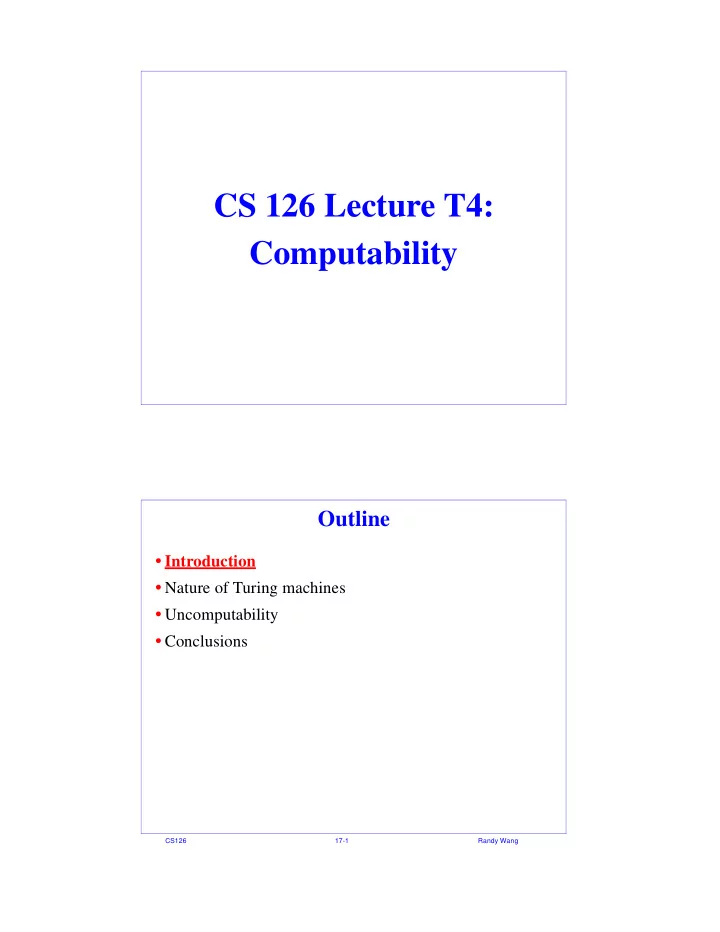

CS 126 Lecture T4: Computability Outline • Introduction • Nature of Turing machines • Uncomputability • Conclusions CS126 17-1 Randy Wang
Where We Are • T1 - Simplest language generators: regular expressions - Simplest language recognizer: FSAs • T2: more powerful machines - FSA, NFSA - PDA, NPDA - TM • T3: more powerful languages associated with the more powerful machines • T4: - Nature of TM: the most powerful machines - Languages that no machine can ever deal with CS126 17-2 Randy Wang Limits • Intuively, machines are finite representations of languages • There are “more” languages than machines (“uncountable” vs. “countable”) • Therefore, there have to be some “weird” languages! Let’s look for those! CS126 17-3 Randy Wang
CS126 17-4 Randy Wang Post’s Correspondence Examples ABABABABA CS126 17-5 Randy Wang
Outline • Introduction • Nature of Turing machines - Can match power of any sophisticated automata - Can match power of any real special purpose computer - Can be made general to simulate any special purpose TM - Therefore can match power of any real general purpose computer - In fact, it can match the power of any computation methods • Uncomputability • Conclusions CS126 17-6 Randy Wang TM: the Ultimate Machine! • “Power” = ability to recognize languages • “Impossible” to make a Turing Machine more powerful! • All the following attempts have been proven to be equivalent to a vanilla TM: - Composition of multiple TMs - Multiple tapes - Multiple read/write heads - Multi-dimensional tapes - Non-determinism • In other words, we can construct a regular TM that is equivalent to any of these CS126 17-7 Randy Wang
TMs: as Powerful as any Real Programs Data Data Instruction Instruction Control Instruction Instruction TOY TM Control Data CS126 17-8 Randy Wang TMs: as Powerful as any Real Programs CS126 17-9 Randy Wang
Universal Turing Machine • So far, we have built special purpose TMs for each different problem, example: one that recognizes palindrome • This is like special purpose computers piror to von Neumann store-program computers • Question: can we make a general purpose TM just like the general purpose computers? • Universal Turing Machine (UTM): a general purpose Turing machine that can simulate the operation of any special purpose TM • How? Just like a von Neumann architecture, the idea is to store the representation of a TM inside a UTM CS126 17-10 Randy Wang What Are the “Ingredients” of a TM? Tape Content The “Program” Current State TM • Three “ingredients” of a special purpose TM: - The TM “program” - The tape content - The current TM state CS126 17-11 Randy Wang
How to Make a UTM? How Does It Work? • Encode the three Encoding of TM’s tape content ingredients of TM using Data memory three tapes of a UTM • UTM (simulates TM) - read tape 1 Encoding of TM’s program - read tape 3 Instruction memory - consult tape 2 for what to do 3 Encoding of TM’s current state - write tape 1 if necessary PC - move head 1 - write tape 3 • Very much like the fetch- incr-execute cycle of a von Neumann machine!! UTM • Can reduce 3-tape UTM to a single-tape one CS126 17-12 Randy Wang Church/Turing Thesis • Turing machines are so powerful that they are basis of the very definition of algorithm : an algorithm is what a TM can do! CS126 17-13 Randy Wang
Church/Turing Thesis (cont.) CS126 17-14 Randy Wang Church/Turing Thesis (cont.) CS126 17-15 Randy Wang
Outline • Introduction • Nature of Turing machines • Uncomputability • Conclusions CS126 17-16 Randy Wang
A Warmup Paradox • Classify statements into two categories: truths and lies • How do we classify the statement “I’m lying”? - If I’m telling the truth, then I’m lying. - If I’m lying, then I’m telling the truth. • Well known problem with self-referential statements: - The barber that must cut hair only for all those who don’t cut their own hair; should the barber cut his own hair? - A set of things that are not members of themselves; is this set a member of itself? (Russell’s Paradox) CS126 17-18 Randy Wang
Unsolvable Problems (cont.) CS126 17-21 Randy Wang
Hilbert’s Tenth Problem (cont.) CS126 17-23 Randy Wang
Outline • Introduction • Nature of Turing machines • Uncomputability • Conclusions - There are far “more” languages than there are machines - Therefore, there are far “more” provably unsolvable problems than solvable ones! - What’s the implication? CS126 17-24 Randy Wang
Recommend
More recommend